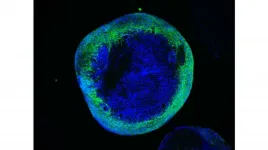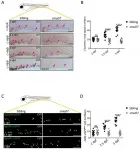Robust cell junctions are critical for maintaining stem cell function
Mechanical instability of adherens junctions overrides intrinsic quiescence of hair follicle stem cells
2021-03-26
(Press-News.org) The skin is the largest organ in the human body, and its outermost part, called the epidermis, is replenished every three weeks. The cells fueling this renewal of the epidermal stem cells, found in specialized areas or niche, within a region of the hair follicle (or root) is known as the 'bulge compartment'. The bulge compartment resident stem cells are multipotent meaning that they can contribute to the repair of skin when it's injured, and also regenerate the hair follicles during normal development. While several groups have focused attention on the stem cells themselves, less is known about niche or extrinsic factors that influence the state of these stem cells.
In the recent paper published in the Developmental Cell, Dr. Srikala Raghavan and her research group at the Centre for Inflammation and Tissue Homeostasis (CITH) theme, DBT-inStem identified the role for robust cell adhesion between stem cells in maintaining their quiescent properties. They focused on a protein called vinculin, a 'mechanotransducer' expressed in the skin. Mechanotransducers are proteins that signal by generating force within the cell via engaging with the cell's cytoskeleton. Vinculin is found at the junctions between cells, also known as the 'adherens junction', and between the cell and the substratum, known as the 'focal adhesion'. When the research team deleted the vinculin gene from the epidermal compartment (known as a conditional knockout, cKO), they found to their surprise that the animals were perfectly normal other than displaying a sparse coat of hair.
Ritusree Biswas, a graduate student in the Raghavan lab focused her analysis on exploring the behavior of hair follicles' stem cells. Her studies revealed that the stem cells in the vinculin cKO failed to maintain quiescence. Because the stem cells were constantly dividing, she was able to show that these cells no longer functioned like classical stem cells, which in turn contributed to the sparse hair phenotype. Avinanda Banerjee, another author on the publication, focused on the mechanism underpinning the loss of quiescence in these stem cells. She examined mechanotransduction or forces generated by cells that lacked vinculin in collaboration with Prof. Yan Jie and his post doc, Zhihai Zhao, at the Mechanobiology Institute (MBI), Singapore. When Avinanda measured the forces at cell junctions generated by the vinculin KO (knockout) cells, she discovered that these cells generated only about half the force than a normal cell that expresses vinculin. This data suggested that the loss of vinculin was making the junctions weak. This was very surprising since they had shown that all of the proteins which were normally present at the junctions were present, in fact at higher levels.
The research team then focused on understanding the relationship between the weak junctions and loss of stem cell quiescence. They performed global gene expression profiling of vinculin KO cells to identify pathways that may have changed due to the loss of vinculin. One of pathways that was significantly changed was the YAP1 pathway. YAP1 is a transcription factor and controls the expression of genes that regulate the cell cycle. The increased expression of YAP1 in the KO provided an explanation for increased cell proliferation and loss of quiescence. So why is YAP1 expression dysregulated? It turns out that since YAP1 is such a potent regulator of cell proliferation, it is normally sequestered at the strong cell-cell junctions found in quiescent stem cells, otherwise known as a 'contact inhibited state'. However, since the junctions in the vinculin KO cells were weak, YAP1 was no longer sequestered at these junctions and could translocate into the nucleus and regulate cell proliferation.
This recent work by the Raghavan lab has implications beyond skin stem cells. When cancer cells metastasize out of their niche, there is a reduction in the expression of cell junction proteins and a concomitant increase in the expression of YAP1. In ongoing work, Srikala's lab is exploring how the loss of vinculin affects signals received by the nucleus.
INFORMATION:
This work is a collaboration with an international team of scientists that includes Colin Jamora (inStem, IFOM JRL), Dasaradhi Palakodeti (inStem), Robert Ross (UCSD), Yan Jie (MBI, Singapore) and Valera Vasioukhin (Fred Hutch, Seattle). This work was supported by the Science & Engineering Research Board (SERB), Department of Science and Technology (DST), India, and the Institute for Stem Cell Science and Regenerative Medicine (InStem) at Bangalore.
[Attachments] See images for this press release:

ELSE PRESS RELEASES FROM THIS DATE:
2021-03-26
Leigh syndrome is the most severe mitochondrial disease in children. It causes severe muscle weakness, movement defects, and intellectual disabilities. It usually leads to death within the first years of life. No causative treatment is currently available. One of the genes frequently mutated in patients is SURF1, which encodes for a protein involved in the process of energy generation in the cells. Animal models did not recapitulate the defects seen in the patients carrying mutations in SURF1. Therefore, the scientists did not have the tool to start understanding the disease mechanisms and to identify possible targets for treatment. They report about the first ...
2021-03-26
Apple flies have fascinated scientists right from the mid-19th century, as they are a captivating example of speciation, the beginning of a new species. Correspondence between Charles Darwin and Benjamin Walsh, who observed the apple flies and hawthorn flies in North America, began the rich history of this scientific question in evolutionary biology. When settlers in North America introduced apple trees to the region, what happened within the hawthorn flies to make them shift to this new host plant in the last 300 years?
Continuing the 160-year-old inquiry into the origins of the apple fly, a team of scientists from around the world has just published their research in the Proceedings of the Royal Society B. The researchers span three continents, from the National Centre for Biological ...
2021-03-26
Hematopoietic stem/progenitor cells (HSPCs) include hematopoietic stem cells and several lineage-biased hematopoietic progenitor cells, which can provide all blood cell types in an adult organism. Among them, hematopoietic stem cells have the ability of self-renewal and multi-lineage differentiation, and can rapidly respond under acute hematopoietic conditions. Meanwhile, the hematopoietic progenitor cells can maintain the supply of blood cells in homeostatic hematopoiesis. In a word, HSPCs are the core of the blood system, once their homeostasis is destroyed, it will lead to serious blood diseases and even death. Therefore, the researches associated with the HSPCs can provide a strong support for relevant ...
2021-03-26
Almost all wild canines in Australia are genetically more than half dingo, a new study led by UNSW Sydney shows - suggesting that lethal measures to control 'wild dog' populations are primarily targeting dingoes.
The study, published today in Australian Mammalogy, collates the results from over 5000 DNA samples of wild canines across the country, making it the largest and most comprehensive dingo data set to date.
The team found that 99 per cent of wild canines tested were pure dingoes or dingo-dominant hybrids (that is, a hybrid canine with more than 50 per cent dingo genes).
Of the remaining ...
2021-03-26
Irvine, Calif., March 25, 2021 -- A short-term intervention in daily fiber consumption can significantly alter the gut microbiome and nutrient intake, according to a study led by University of California, Irvine researchers. The research was recently published by the American Society for Microbiology.
Dietary fiber consists of resistant carbohydrates found in fruits, vegetables and whole grains. Fiber persists in our digestion system, and while not digestible by humans, our gut bacteria can metabolize fiber into short-chain fatty acids and other byproducts critical to human health.
Currently, the average person in North America consumes less than 50 percent of the recommended dietary ...
2021-03-26
Water scarcity is often understood as a problem for regions experiencing drought, but a new study led by Tufts University researchers finds that not only can localized water shortages impact the global economy, but changes in global demand can have positive and negative ripple effects in river basins across the globe.
In addition to Tufts engineers, the team included experts from the Joint Global Change Research Institute at the Pacific Northwest National Laboratory, and Cornell University.
"We're finding that water scarcity dynamics are more complicated than traditionally acknowledged," said Flannery Dolan, a graduate student ...
2021-03-26
International genomics research led by the University of Leicester has used artificial intelligence (AI) to study an aggressive form of cancer, which could improve patient outcomes.
Mesothelioma is caused by breathing asbestos particles and most commonly occurs in the linings of the lungs or abdomen. Currently, only seven per cent of people survive five years after diagnosis, with a prognosis averaging 12 to 18 months.
New research undertaken by the Leicester Mesothelioma Research Programme has now revealed, using AI analysis of DNA-sequenced mesotheliomas, that they evolve along similar or repeated paths between individuals. These paths predict the aggressiveness and possible therapy of this otherwise incurable cancer.
Professor ...
2021-03-26
Bottom Line: Various genetic alterations in circulating tumor cells (CTCs) were associated with clinical outcomes and resistance to hormone therapy in patients with metastatic castrate-resistant prostate cancer (mCRPC).
Journal in Which the Study was Published: Molecular Cancer Research, a journal of the American Association for Cancer Research
Author: Andrew Armstrong, MD, MSc, a medical oncologist at the Duke Cancer Institute Center for Prostate and Urologic Cancers at Duke University
Background: While only a minority of men with mCRPC have primary resistance to the androgen receptor (AR) inhibitors enzalutamide (Xtandi) or abiraterone acetate (Yonsa or Zytiga), most men will ...
2021-03-26
A study with first-time learners of Japanese has measured how brain activity changes after just a few months of studying a new language. The results show that acquiring a new language initially boosts brain activity, which then reduces as language skills improve.
"In the first few months, you can quantitatively measure language-skill improvement by tracking brain activations," said Professor Kuniyoshi L. Sakai, a neuroscientist at the University of Tokyo and first author of the research recently published in Frontiers in Behavioral Neuroscience.
Researchers followed 15 volunteers as they moved to Tokyo and completed introductory Japanese classes for at least three hours each day. All volunteers ...
2021-03-26
March 23, 2021-- A new study published online in the Annals of the American Thoracic Society examines if the source of physician payment for a medical opinion influences whether the physician finds that a coal miner has black lung disease. The study is the first to look at this relationship in the workers' compensation process.
In "Association Between Financial Conflicts of Interest and ILO Classifications for Black Lung Disease," Lee S. Friedman, PhD, associate professor, School of Public Health, Division of Environmental and Occupational Health Sciences, University of Illinois Chicago and colleagues looked at which party reimbursed B-readers--physicians trained and licensed by the National Institute for Occupational Safety and Health (NIOSH) and approved by the U.S. ...
LAST 30 PRESS RELEASES:
[Press-News.org] Robust cell junctions are critical for maintaining stem cell function
Mechanical instability of adherens junctions overrides intrinsic quiescence of hair follicle stem cells






